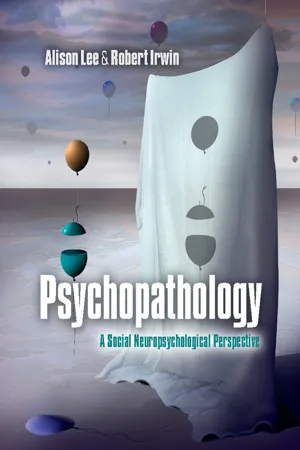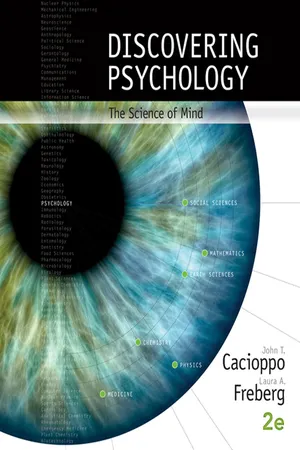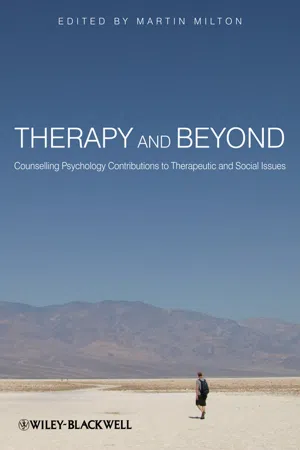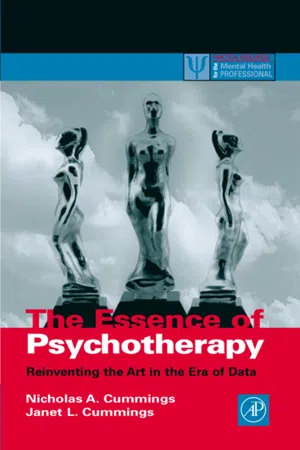Psychology
Psychotherapy
Psychotherapy is a form of treatment that involves talking with a trained therapist to address emotional, behavioral, and psychological challenges. It aims to help individuals understand their thoughts, feelings, and behaviors, and develop coping strategies to improve their mental well-being. Psychotherapy can be conducted through various approaches, such as cognitive-behavioral therapy, psychodynamic therapy, and humanistic therapy.
Written by Perlego with AI-assistance
Related key terms
1 of 5
11 Key excerpts on "Psychotherapy"
- No longer available |Learn more
- (Author)
- 2014(Publication Date)
- College Publishing House(Publisher)
________________________ WORLD TECHNOLOGIES ________________________ Chapter 9 Psychotherapy Psychotherapy , or personal counseling with a psychotherapist, is an intentional interpersonal relationship used by trained psychotherapists to aid a client or patient in problems of living. It is a talking therapy and aims to increase the individual's sense of their own well-being. Psychotherapists employ a range of techniques based on experiential relationship building, dialogue, communication and behavior change that are designed to improve the mental health of a client or patient, or to improve group relationships (such as in a family). Psychotherapy may also be performed by practitioners with a number of different qualifications, including psychiatry, clinical psychology, clinical social work, counseling psychology, mental health counseling, clinical or psychiatric social work, marriage and family therapy, rehabilitation counseling, music therapy, art therapy, drama therapy, dance/movement therapy occupational therapy, psychiatric nursing, psychoanalysis and others. It may be legally regulated, voluntarily regulated or unregulated, depending on the jurisdiction. Requirements of these professions vary, but often require graduate school and supervised clinical experience. Regulation Continental Europe In Germany, the Psychotherapy Act (PsychThG, 1998) restricts the practice of Psychotherapy to the professions of psychology and psychiatry. In Italy, the Ossicini Act (no. 56/1989, art. 3) restricts the practice of Psychotherapy to graduates in psychology or medicine who have completed a four-year postgraduate course in Psychotherapy at a training school recognised by the state; French legislation restricts use of the title psychotherapist to professionals on the National Register of Psychotherapists;. - eBook - ePub
Understanding Troubled Minds Updated Edition
A guide to mental illness and its treatment
- Sidney Bloch(Author)
- 2014(Publication Date)
- Melbourne University Press Digital(Publisher)
Defining Psychotherapy is tricky for at least four reasons. Firstly, many psychological treatments are available, each with its own rationale and methods. Secondly, however well planned, these treatments are to a varying extent unpredictable in their application. The reasons for this are obvious once you think about the nature of the process. Psychotherapy is influenced by many unique features, among them the patient’s type of personality, the presenting problems, motivation for change and capacity for reflecting about oneself. Thirdly, treatment is also influenced by therapist’s personal qualities and the values they espouse; in this regard, the therapist–patient relationship is all-important. Finally, goals of treatment range from relief of symptoms (as in behaviour therapy) to radical personality change (as in insight-oriented approaches like psychoanalysis).The task of definition is eased by referring to ‘the psychotherapies’, since we are concerned with an array of treatments, applied for varied purposes. (Counselling is related to Psychotherapy but usually regarded as distinct from it—I shall address it briefly later in the chapter). All psychotherapies involve two foundational features. The first is a relationship between a trained health professional (psychiatrist, psychologist and social worker are the principal groups) and a person needing help to deal with psychological distress (for example, depression, anxiety, guilt, poor self-esteem, unresolved grief) and disturbed functioning (for example, failure in maintaining intimate relationships, marital strife, poor coping with stress). The second feature is the planned, systematic application of specific psychological principles.Factors that unite the therapies
This succinct definition covers all psychotherapies, although the person’s particular difficulties, and the psychological principles applied vary considerably. On the other hand, certain features unite the psychotherapies. These common basic factors were originally formulated by Jerome Frank, a pioneering Psychotherapy researcher, in the early 1970s. Given the systematic studies of his group, we can conclude confidently that these factors are necessary but not sufficient for the practice of the psychotherapies, and that we also need to incorporate additional psychological principles. - eBook - ePub
Counseling and Psychotherapy
A Christian Perspective
- Siang-Yang Tan(Author)
- 2022(Publication Date)
- Baker Academic(Publisher)
He suggests that “psychological treatments” should refer to those dealing primarily with pathology, while “Psychotherapy” should refer to treatments that address adjustment or growth (2006, 216). Psychological treatments are therefore those that are clearly compatible with the objectives of health-care systems that address pathology. He further stresses that the two activities of psychological treatment (which is more specific) and Psychotherapy (which is more generic) would not be distinguished based on theory, technique, or evidence, but only on the problems they deal with. He is aware that these are controversial recommendations. However, I believe Barlow’s (2006) recommendation is not only controversial but also potentially confusing and may not really help to clarify the definition of terms. Examples of psychological treatments provided by Barlow include “assertive community treatment, cognitive- behavioral therapy, community reinforcement approaches, dialectical behavior therapy, family focused therapy, motivational interviewing, multisystemic interpersonal therapy, parent training (for externalizing disorders in children), personal therapy for schizophrenia, and stress and pain management procedures” (2004, 873, emphasis in original). We can see that many of these examples of psychological treatments are already part and parcel of counseling and Psychotherapy. Overview of Counseling and Psychotherapy: Theory Although over five hundred varieties of counseling and Psychotherapy presently exist, most of them can be subsumed under the major schools of counseling and Psychotherapy that are usually covered in textbooks in this field of people-helping. There are usually eleven to fifteen major ones, depending on the author and the text. In this book the following thirteen major theoretical approaches to counseling and Psychotherapy will be covered in some detail (in chaps - eBook - PDF
Psychotherapy
Theory, Practice, Modern and Postmodern Influences
- Laurence Simon(Author)
- 1994(Publication Date)
- Praeger(Publisher)
I make no attempt on these pages to provide an overall framework for others to follow or to specify techniques. Psychotherapy" defines a professional human relationship. To the degree that it is a human relationship, it is similar to all other relationships. To the degree that it is determined by the demands of a profession, it differs from all other relationships. Psychotherapy" involves a human relationship that is guided by scientific concepts but follows humanistic rules of moral conduct. To the degree that "therapy" operates according to its scientific method and moral precepts is the degree to which it is often a unique human relationship and, in my opinion, represents a goal for all human relationships. The effectiveness of therapy is determined by the degree to which this relationship is different from others that the patient has experienced and by the degree to which the therapist and patient can establish a relationship in which the patient experiences the difference. The core of the therapeutic process is found in the relationship that forms between patient and therapist and not merely in the technique employed by the therapist. The techniques employed in Psychotherapy" by the therapist are those that grow organically out of the therapeutic relationship. Techniques are, therefore, the behaviors of the thera- 182 The Practice of Psycho" therapy" pist that emerge from his or her personal paradigm as he or she attempts to define a scientific-humanistic relationship new to the experiences of the patient. The techniques of the therapist are the skills of his or her personal paradigm, of his or her being in the world in a time and place as defined by the encounter between himself or herself and the patient. I stress this point because so often therapists, casting about for "something that works," adopt behaviors that are imitative of some expert. - Lorelle J. Burton, Drew Westen, Robin M. Kowalski(Authors)
- 2022(Publication Date)
- Wiley(Publisher)
Therapist: Then, there are two of you walking around. Patient: There are two of us. (Laughs) Source: Strupp and Binder (1984). INTERIM SUMMARY Psychodynamic therapy rests on two principles: insight (coming to an understanding of the way one’s mind works) and the relationship between the patient and therapist. To bring about change, therapists rely on three techniques: free association (exploring associational networks by having the patient say whatever comes to mind); interpretation (efforts to help the patient come to understand their experiences in a new light); and examination of transference (where by people transfer thoughts, feelings, fears, wishes and conficts from past relationships onto the therapist, re-enacting repetitive interpersonal interaction patterns). The main contemporary forms of psychodynamic treatment are psychoanalysis (in which the patient lies on the couch and meets with the therapist three or more times a week) and psychodynamic Psychotherapy (in which the patient and therapist sit face-to-face and usually meet once or twice a week). 19.3 Cognitive–behavioural therapies LEARNING OUTCOME 19.3 Describe the key principles and techniques of cognitive–behavioural therapies. Psychodynamic approaches were the first approaches to Psychotherapy, and they emerged from clinical practice. In the late 1950s and early 1960s, an alternative approach emerged from the laboratory. This approach viewed symptoms as maladaptive learned behaviour patterns that could be changed by applying behaviourist principles of learning (Eysenck, 1952, 1964; Wolpe, 1964). Although many therapists continue to practise behaviour therapy (treatment based primarily on behaviourist learning principles), Pdf_Folio:988 988 Psychology most who make use of learning principles today are cognitive–behavioural in their orientation, using methods derived from behaviourist and cognitive approaches to learning. Basic principles Cognitive–behavioural therapies are typically short term.- eBook - PDF
Psychopathology
A Social Neuropsychological Perspective
- Alison Lee, Robert Irwin(Authors)
- 2018(Publication Date)
- Cambridge University Press(Publisher)
10 Psychological Therapies Introduction With over 400 different types of psychological therapy, it is unsurprising that no definition exists that adequately captures this diverse field of practice. Although modern psychological therapies have relatively short histories, the elements from which most are constituted are similar and date back many centuries (Jackson, 1999). For the purposes of this chapter, we use the term psychological therapy to refer to Psychotherapy, counselling or any form of ‘talking treatment’ that aims to promote subjective well-being and mental health. This chapter aims to help you to think more critically about the claims made about psychological therapies. Firstly, we consider whether the practice of psychological therapy should be guided by diagnosis or formulation. This debate is, in part, about the extent to which the practice of psychological therapy can or should be decoupled from the medical model (Sanders, 2007; Deacon, 2013). In the next section, the focus shifts to how we can establish whether a psychological therapy works. Here we introduce and critique the concept of empirically supported therapies. Opinion within the field of psycho- logical therapy is generally divided as to which elements of therapy help to bring about change; some claim that it is therapeutic techniques and the theories that underpin them (the differential effectiveness position), while others argue that it is the quality of the therapeutic relationship and nonspecific factors (the common factors position). In the final part of the chapter, we consider some of the potential detrimental effects psychological therapy may have at an individual and societal level. 10.1 Diagnosis or Formulation? Whether practice should be guided by diagnosis or formulation is a moot point in the field of psychological therapy. In the therapeutic process, it is usually a diagno- sis or formulation that links assessment to therapeutic intervention or ‘treatment’. - eBook - PDF
Discovering Psychology
The Science of Mind
- John Cacioppo, Laura Freberg(Authors)
- 2015(Publication Date)
- Cengage Learning EMEA(Publisher)
3. Analyze the key principles of psychoanalytic, humanistic, behavioral, and cognitive Psychotherapy techniques. 4. Explain the biological mechanisms by which medication, electroconvulsive therapy, psychosurgery, deep brain stimulation, and neurofeedback are thought to alleviate symptoms of disorder. 5. Integrate biological and psychotherapeutic approaches to treating neurodevelopmental disorders, schizophrenia, bipolar disorder, major depressive disorder, anxiety disorders, OCD, posttraumatic stress disorder (PTSD), and personality disorders. How Do Psychologists Provide Therapy? Chapter 14 explored a diverse range of problems that can contribute to personal and interper-sonal distress. Once considered virtually untreatable, many of these disorders respond posi-tively to the treatments available today. Unfortunately, many people with disorders still do not seek help, possibly because of some of the stigma related to having a psychological problem or a lack of awareness that effective help is available (see ● Figure 15.1). Sixty years ago, many people diagnosed with schizophrenia faced a discouraging future of institutionalization and little improvement (see ● Figure 15.2). Today, although about 30% of patients with schizo-phrenia do not seem to respond to available treatments, the other 70% experience some relief from their troubling symptoms (Bobo & Meltzer, 2010). Approaches to Treatment Psychological treatments, or psychotherapies , which generally involve a conversation be-tween the professional providing the therapy and the person seeking help, are often combined with biological treatments, such as the medications described in more detail in later sections of this chapter. For example, a person who is terrified of being part of a crowd might benefit from a combination of Psychotherapy and medication for anxiety. As we will see in this chap-here, while others take the form of medication and other biological treatments. - eBook - PDF
Therapy and Beyond
Counselling Psychology Contributions to Therapeutic and Social Issues
- Martin Milton(Author)
- 2010(Publication Date)
- Wiley(Publisher)
Advances on what have gone Therapy and Beyond: Counselling Psychology Contributions to Therapeutic and Social Issues Edited by Martin Milton © 2010 John Wiley & Sons, Ltd. 140 Therapy and Beyond before mark out the difference between art and craft – to be good at what you do is craft, to add something new that makes sense across past and present spectrums constitutes the transformation into art. For instance, in the disci-pline of psychology, theory of mind (Baron-Cohen et al ., 1985) has helped to inform development of mentalisation-based approaches (Bateman & Fonagy, 2004) which are rooted in psychoanalytic tradition but which also speak fluently to cognitive behavioural and dialectic behaviour therapies. The craft of therapy, irrespective of theoretical model, is to find new contexts and new understandings in which to place the lived experiences of those in distress, those desiring change and those whose needs may be unmet. As individuals we lead our lives in the present on the basis of what has happened in the past or on what has been inferred from the experience of the past. How fitting, then, that psychoanalytic theory invests much in the developmental histories of individual lives in order to contribute to the discovery of new experiences within relationships. It is also fitting that counselling psychology acknowledges the centrality of relationships across the whole of the spectrum of mental health presentations. Indeed, counselling psychology originates from an innovative movement intent on progressing professional understandings of the application of psychology from their clinical roots into the realm of the relational and the dynamic. In that sense, at its inception counselling psychology was an artistic departure from traditional clinical practice. - eBook - PDF
The Essence of Psychotherapy
Reinventing the Art for the New Era of Data
- Nicholas A. Cummings(Author)
- 2000(Publication Date)
- Academic Press(Publisher)
He became active in his temple and in two Jewish 36 The Essence of Psychotherapy charities, and he restructured his law practice into more meaning-ful, albeit less lucrative channels. For the first time in his life he felt that life was tranquil, and that he was neither running away from something he did not understand nor chasing something elusive. His health plan, however, paid for only the first eight ses-sions of a year and a half of semi-weekly treatments. Psychotherapy IS ALSO PSYCHOPHARMACOLOGY Increasingly psychologists are treating patients whose psy-chopathology involves a disordered brain or neurochemistry. These patients are receiving medication in conjunction with psy-chotherapy, which a number of studies reveal to be the optimal arrangement. For some the Psychotherapy increases compliance with the medical regimen; for others it provides the psychother-apy which, without the medication, would not have been possi-ble; for still others it completes the treatment necessary for the patient to function effectively. There are very few psychotic and organic conditions for which accompanying Psychotherapy is not a desirable, and perhaps necessary, component. The Case of Sarah and the Wrong Treatment A 31-year-old single woman had seen three different psychologists over a nine-year period. The change in therapists was the result of relocation—originally from New York to Chicago, and finally to San Francisco. The first psychologist had treated Sarah for a borderline personality disorder, and because of her constant turmoil, poor social relationships, and disastrous employment history, the next two psychotherapists saw no reason to alter the diagnosis. That is, until Sarah suffered the first full-fledged bipolar episode, beginning with mania and culminating in a depression that required hospital-ization. During her mania she became very sexually promiscuous, Psychotherapy Is an Amalgam of All Techniques and Competencies 37 - eBook - PDF
- Douglas Bernstein, , , (Authors)
- 2015(Publication Date)
- Cengage Learning EMEA(Publisher)
Debate over Eysenck’s findings and the contradictory reports that followed them highlight several reasons why it is so hard to answer the apparently simple question of whether Psychotherapy works. For one thing, there is the problem of how to measure improvement in Psychotherapy. Should we focus on psychological test results, behavioral observations, interviews, or a combination of all three? Different measurements may tell somewhat different stories about improvement, making it difficult for researchers to LINKAGES Can therapy change person- ality? (a link to Personality) IN REVIEW APPROACHES TO PSYCHOLOGICAL TREATMENT (CONT.) Dimension Classical Psychoanalytic Contemporary Psychodynamic Humanistic Behavioral/Cognitive Behavioral Goals Psychosexual maturity through insight; strengthening of ego functions Correcting effects of early attachment failures; developing satisfying intimate relationships Expanded awareness; fulfillment of potential; self-acceptance Changes in thinking and behavior in particular classes of situations; better self-management Typical methods Free association; dream analysis, analysis of transference Analysis of interpersonal relationships, including the client-therapist relationship Reflection-oriented interviews convey unconditional positive regard, empathy, and congruence; exercises to promote self-awareness Systematic desensitization, flooding, implosive therapy, modeling, assertiveness and social skills training, positive reinforcement, extinction, aversion conditioning, punishment, cognitive restructuring In Review Questions 1. Object relations therapy and interpersonal therapy are both contemporary examples of the _ approach to psychological treatment. 2. Imagining increasingly fear-provoking stimuli while relaxed is a treatment method called _ . 3. Reflection is an interviewing technique associated mainly with the _ approach to treatment. Copyright 2016 Cengage Learning. All Rights Reserved. - eBook - PDF
- Ronald Comer, Elizabeth Gould, Adrian Furnham(Authors)
- 2014(Publication Date)
- Wiley(Publisher)
CHAPTER 20 TREATMENT OF PSYCHOLOGICAL DISORDERS 596 Formats of Therapy LEARNING OBJECTIVE 6 Describe commonly used formats of therapy. Individual therapy , or treatments con- ducted by individual therapists with indi- vidual clients, is the oldest of the modern therapy formats. Other formats include group therapy, family and couple therapy and community treatment. Therapists may apply their partic- ular approach in each of these formats and additional strate- gies have also been developed for use in the non-individual formats. Group Therapy In group therapy , a therapist sees several clients with psychological problems at the same time. Group therapy became a popular format for treating people with psychological difficulties after World War II, when growing demand for psychological services forced therapists throughout the United States and Europe to look for time-saving alternatives to individual therapy. Some therapists now specialize in group therapy, and many oth- ers conduct therapy groups as one aspect of their practice. A survey of clinical psychologists, for example, revealed that almost one-third of them practise group therapy to some degree (Norcross & Goldfried, 2005). Typically, group members meet with a therapist and dis- cuss the problems or concerns of one or more of the mem- bers (Burlingame & Baldwin, 2011). Groups are often created with particular client populations in mind. For example, there are groups for people with alcoholism, for people who are physically handicapped and for people who are divorced, abused or bereaved. Irvin Yalom, a group-therapy theorist, suggests that suc- cessful forms of group therapy share certain ‘curative’ fea- tures (Cox et al., 2008; Yalom & Leszcz, 2005): • Guidance. They usually provide information and advice for members. • Identification. They provide models of appropriate behaviour. • Group cohesiveness. They offer an atmosphere of soli- darity in which members can learn to take risks and accept criticism.
Index pages curate the most relevant extracts from our library of academic textbooks. They’ve been created using an in-house natural language model (NLM), each adding context and meaning to key research topics.










